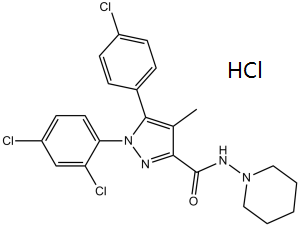Rimonabant HCl (SR141716)
This product is for research use only, not for human use. We do not sell to patients.

For small sizes, please check our retail website as below: www.invivochem.com
| Size | Price | Stock |
|---|---|---|
| 500mg | $650 | Check With Us |
| 1g | $1150 | Check With Us |
| 5g | $2999 | Check With Us |
Cat #: V3565 CAS #: 158681-13-1 Purity ≥ 98%
Description: Rimonabant (also known as SR141716, SR-141716A; A 281) is a novel, potent and selective antagonist (inverse agonist) of cannabinoid CB1 receptor with IC50 of 13.6 nM and EC50 of 17.3 nM in hCB1 transfected HEK 293 membrane.
Top Publications Citing Invivochem Products
Publications Citing InvivoChem Products
Product Promise

- Physicochemical and Storage Information
- Protocol
- Related Biological Data
- Stock Solution Preparation
- Quality Control Documentation
| Molecular Weight (MW) | 500.25 |
|---|---|
| Molecular Formula | C22H22Cl4N4O |
| CAS No. | 158681-13-1 |
| Storage | -20℃ for 3 years in powder formr |
| -80℃ for 2 years in solvent | |
| Solubility In Vitro | DMSO: >30 mg/mLr |
| Water: N/Ar | |
| Ethanol: N/A | |
| Solubility In Vivo | 30% PEG400+0.5% Tween80+5% Propylene glycol: 30 mg/mL |
| Synonyms | SR141716 HCl; A281; SR 141716A; SR-141716; A-281; SR 151716A; SR 141716; SR-141716; A 281; SR-141716A; SR-151716A; SR141716A; SR151716A; Rimonabant, Acomplia, Zimulti |
| Protocol | In Vivo | Rimonabant (10 mg/kg by gavage) is fed for 2 weeks to 3-month-old male obese Zucker rats as an impaired glucose tolerance model and for 10 weeks to 6-month-old male obese Zucker rats as a model of the metabolic syndrome. RANTES and MCP-1 serum levels are increased in obese vs lean Zucker rats and significantly reduced by long-term treatment with Rimonabant, which slowes weight gain in rats with the metabolic syndrome. Neutrophils and monocytes are significantly increased in young and old obese vs lean Zucker rats and lowered by Rimonabant. Platelet-bound fibrinogen is significantly enhanced in obese vs lean Zucker rats of both age, and is reduced by Rimonabant |
|---|
These protocols are for reference only. InvivoChem does not
independently validate these methods.
| Solvent volume to be added | Mass (the weight of a compound) | |||
|---|---|---|---|---|
| Mother liquor concentration | 1mg | 5mg | 10mg | 20mg |
| 1mM | 1.9990 mL | 9.9950 mL | 19.9900 mL | 39.9800 mL |
| 5mM | 0.3998 mL | 1.9990 mL | 3.9980 mL | 7.9960 mL |
| 10mM | 0.1999 mL | 0.9995 mL | 1.9990 mL | 3.9980 mL |
| 20mM | 0.1000 mL | 0.4998 mL | 0.9995 mL | 1.9990 mL |
The molarity calculator equation
Mass(g) = Concentration(mol/L) × Volume(L) × Molecular Weight(g/mol)
Mass
=
Concentration
×
Volume
×
Molecular Weight*
The dilution calculator equation
Concentration(start)
×
Volume(start)
=
Concentration(final)
×
Volume(final)
This equation is commonly abbreviated as: C1 V1 = C2 V2
Concentration(start)
C1
×
Volume(start)
V1
=
Concentration(final)
C2
×
Volume(final)
V2
Step One: Enter information below
Dosage mg/kg
Average weight of animals g
Dosing volume per animal µL
Number of animals
Step Two: Enter the in vivo formulation
%DMSO
+
%
+
%Tween 80
+
%ddH2O
Calculation Results:
Working concentration:
mg/ml;
Method for preparing DMSO master liquid:
mg
drug pre-dissolved in
µL
DMSO(Master liquid concentration
mg/mL)
,Please contact us first if the concentration exceeds the DMSO solubility of the batch of drug.
Method for preparing in vivo formulation:
Take
µL
DMSO master liquid, next add
µL
PEG300, mix and clarify, next add
µL
Tween 80,mix and clarify, next add
µL
ddH2O,mix and clarify.
Note:
- (1) Please be sure that the solution is clear before the addition of next solvent. Dissolution methods like vortex, ultrasound or warming and heat may be used to aid dissolving.
- (2) Be sure to add the solvent(s) in order.




































